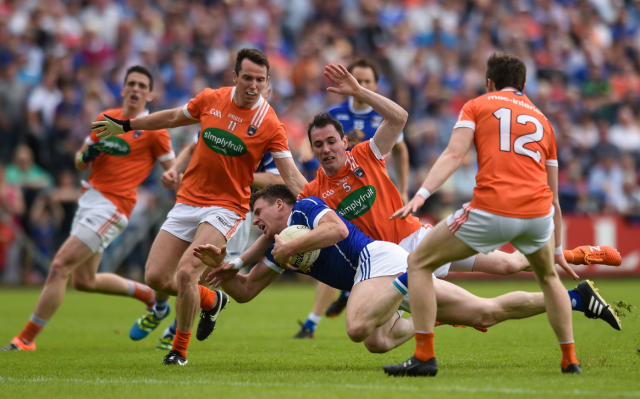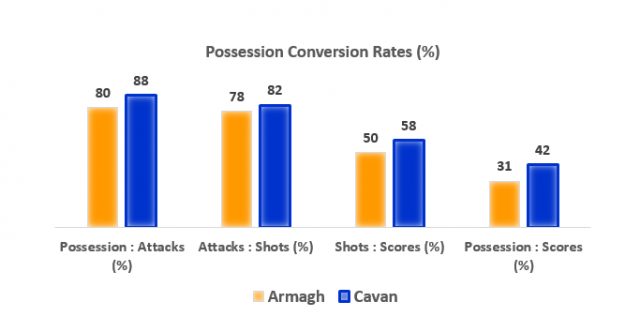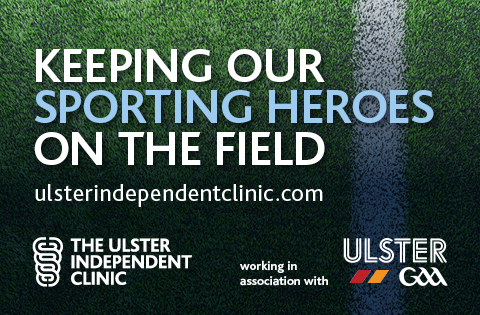Cavan v Armagh Statistical Analysis

USFC 2016: Cavan v Armagh, Quarter Final, Kingspan Breffni Park
Performance analysis has become a major component of the coaching process. A combination of statistical information and video clips allow coaches to analyse performance and provide feedback on both individual and team performance. The same process also allows a coaching team to establish positives and negatives from each performance, and should provide them with a guide as to the needs of the team in subsequent training sessions.
Throughout the Ulster Senior football championship 2016, Ulster GAA will be providing statistical analysis, supported by video clips analysing each game.
Possession
Possession is considered a key factor in match analysis, despite the fact little evidence exists to suggest superior possession share relates to successful outcome. In many sports, possession is measured as percentage of time spent on the ball. However, in GAA, it is more pertinent to assess possession as a count – the number of possessions each team has during a game.

Cavan were the first team in the 2016 USFC to win, despite an inferior share of possession. Armagh had 45 possessions, shading the balance, with Cavan only having 43. However, Cavan were better able to progress possession into the attacking third, and generate shooting opportunities. And with an extremely clinical shot success of 58%, Cavan’s overall efficiency with possession formed the cornerstone of their victory. In fact, they converted an USFC high of 42% of possessions to scores. Notably, Armagh’s conversion rate of 31% has only been topped by Cavan and Tyrone (36%) so far in this year’s USFC.

Armagh’s greater percentage share owed mainly to winning the kick out contest. However, there are a number of important sub plots to the statistic that Armagh won 55% of all kick outs. The first, and most telling is the fact that Armagh had 29 kick outs to Cavan’s 18, and therefore had greater control over kick out strategy. Secondly, Armagh opted for short kick outs (inside their own 45m line) on 15 occasions, mostly to players who were free and able to gather possession uncontested.

Finally, and most strikingly, when the numbers are assessed just measuring how teams fared on contested (beyond the 45m line) kick outs, Armagh’s superiority disintegrates, with Cavan winning 63% of all contested kick outs. From an Armagh perspective they must be given credit for identifying that contested kick outs were an issue and thus reverting to a short kick out strategy. The problem this raised was that Armagh were gaining possession in deeper areas of the pitch, so in order to generate a shot they had to progress the ball a much greater distance and through more traffic than when winning possession further up the pitch. In this, lies one of the reasons that Cavan had superior possession conversion statistics.

Shooting Efficiency
Despite one of the lowest possession counts of the USFC 2016 so far, Cavan converted the highest number of scores (18). The key reason lay in their shot success rate of 58%, a return of almost 3 from every 5 shots taken. Once again, only Cavan and Tyrone (55%) produced better than Armagh managed in this game (50%). Unfortunately for Armagh a 50% return would be sufficient to win many other games. Both teams combined to offer the most accurate finsihing yet in the Ulster championship.
Productivity
Productivity is a measure that defines the impact a team has on the scoreboard, relative to the number of possessions they have. It calculates how many total points a team register for every 10 possessions. The calculation considers the value goals can have on performance. Typically, although not true of every match (this game being a good example), a value of 3.0 will be sufficient for a team to be on the right side of the result – that is, a team that registers 3 points from every 10 possessions will regularly win the match.
For the second consecutive weekend in the Ulster Championship we witnessed a record breaking performance (since first use of productivity measurement in 2014). Tyrone returned a value of 4.9 last week, but were surpassed by Cavan, who returned 5.1 points per 10 possessions – a return of more than a point from every 2 possessions. Cavan’s performance owed to a combination of two goals scored and an excellent shot success rate. Armagh, on the other hand, with a rating of 3.1 will be one of the few teams to return over 3.0 and lose this summer. Given Cavan’s prolific form on Sunday Armagh wold have needed to secure a significantly greater volume of possession to compete on the scoreboard.

While both teams, particularly Cavan, will look at their offensive return favourably, they cannot ignore the fact that defensively, neither team, seemed to offer any real resistance when the opposition were in possession. To add further weight to this suggestion, the game offered the lowest number of turnovers to date (36), with Cavan only losing 14 possessions and Armagh 22 in the match. A better way to measure tendency for a team to turnover is measure their turnover rate, relative to the number of possessions they have in the match. Cavan’s turnover rate of 33% is comfortably the best performance this Ulster championship season, however, the question must be asked as to whether this was due to their very positive use of possession or Armagh’s inability to apply sufficient pressure to force mistakes.

Cavan – lessons for training
Statistically, Cavan’s performance, especially in attack was excellent. A clinical 58% shot success and 2 goals, from 2 goal attempts, contributed to an unprecedented productivity of 5.1 points per 10 possessions. However, their performance was not without flaws, flaws which no doubt Tyrone will be primed to exploit if not addressed by Cavan. Some of the key areas Cavan will want to be aware of are;
- Concession of short kick outs. Cavan conceded 15 short kicks, add to that, that Tyrone relied heavily on short kick outs against Derry, then it is imperative Cavan take measures to prevent or pressurise Tyrone into taking long kick outs;
- Cavan conceded 9 free inside the scoring zone against Armagh. While Tyrone were not prolific from free kicks against Derry (50% success), concession of a similar number by Cavan is likely to cost 4 or 5 points over the course of the match;
- Defensively, Cavan allowed Armagh 3.1 points per 10 possessions, and a shot success of 50%. Obviously this is due in part to Armagh, but there may be potential to raise the intensity of tackling and pressure inside their defensive zone.
Armagh – lessons for training
A lot has been said about Armagh’s poor performance, but the back drop to the performance is not as bleak as the result would make it appear. Based on the numbers, and the volume of scores conceded, it would appear Armagh’s defensive system is not particularly effective, yet their attacking output is fairly sound, despite a reported lack of attacking strategy. There are certainly issues that need addressed;
- Over reliance upon short kick outs is limiting potential Armagh attacks, while also offering easy attacking platforms for their opponents. A strategy to create and exploit space for longer kick outs could benefit Armagh greatly, in particular if their opponent pushes up for kick outs, as Cavan did regularly;
- Without doubt Armagh employed a defensive system, however, the intensity of tackling and effectiveness of the defensive effort could be questioned. Armagh only forced turnovers on 14 occasions, with Cavan scoring a point from every 2 possessions. Increased contact on opponents in the attacking third would appear to be key to improving Armagh’s defensive effort;
- Interestingly, 50% (14) of Armagh’s 28 shots were taken by Stefan Campbell. While his ability and accuracy are exceptional, from a team perspective Armagh are in danger about becoming one dimensional. With a lack of variety to their attack, potential opponents may find it easier to plan effective methods of dulling their attacking threat.






